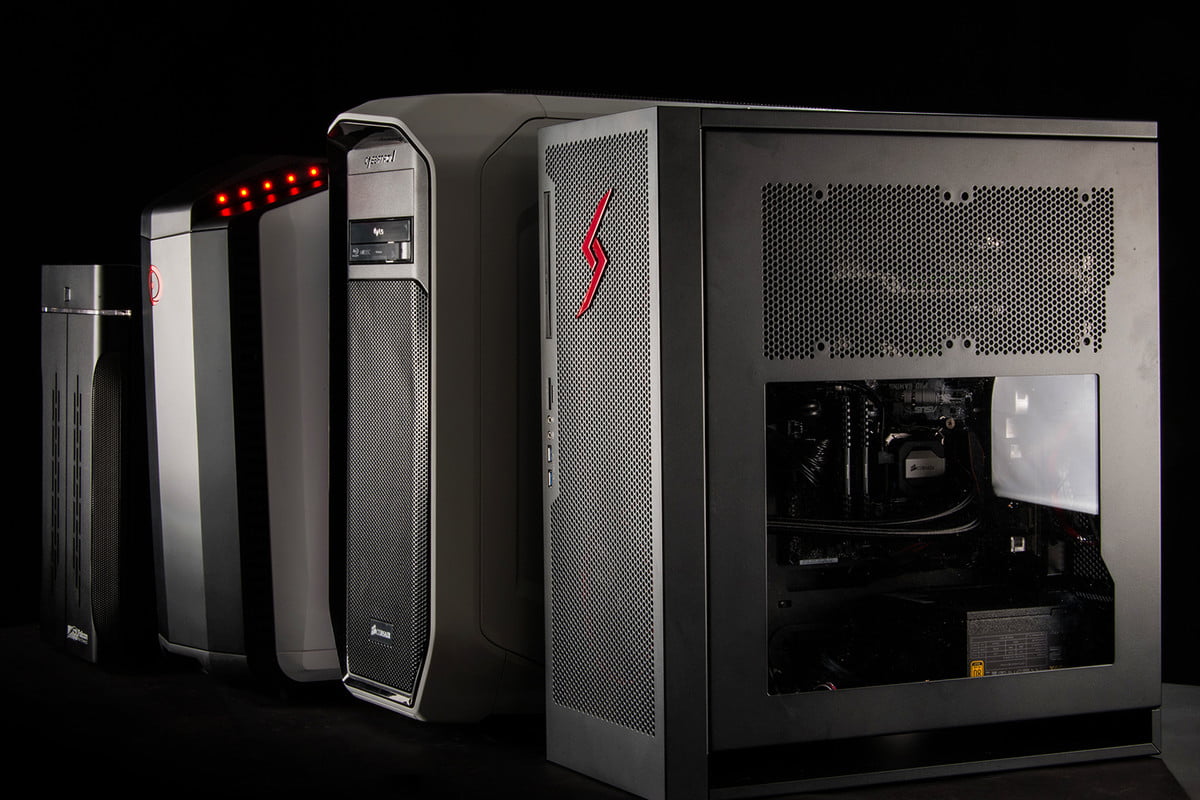

As any PC gamer will tell you, the urge to build the beefiest, most extravagant system is a strong one. They dream of a massive machine with the latest processor, two — no, four of the latest GPU, eight full memory slots, and gallons of liquid coolant pumped through 100 yards of fluorescent tubing. Its appeal is hard to deny, but what a lot of users, especially outside the hobby, don’t understand is that you don’t need to empty your wallet to build a competitive gaming PC.
In fact, it may surprise you to learn that some of the most common components in gaming PCs have been on the market for over two years. We looked at data from a number of sources, including the Steam Hardware Survey, FutureMark’s benchmark leaderboards, a roundup from NZXT’s system management software, and Newegg and Amazon sales, and identified the components that are found in an above-average number of gaming PCs.
Intel’s Core i5 quad is king
Intel clearly dominates its competitor, AMD. The Steam Hardware Report gives Intel 77.2 percent of the market, and the three best-selling processors on Amazon are all Intel chips.
At number four you’ll find the most common AMD chip for system builders, the FX-6300. That chip is half the price, but falls well short of the performance of even Core i3 chips. FutureMark also lists the FX-8350 as the third most popular chip in its results, and there’s no arguing the price per value isn’t a good proposition.
We’ve reviewed some systems powered by the Core i5-4690K, and its benchmark results are surprisingly strong for a chip that’s two years old.
Even among modern competitors, the mid-range Haswell Refresh chip keeps pace, and even beats the Core i5-6600K in the Alienware X51 in the multi-core test, albeit by a slim margin. That’s enough that we only start seeing it bottleneck the Titan and GTX 1080 in Fire Strike results. Anything short of that, and the Core i5-4690K has no trouble keeping pace.
That’s why the Intel’s Core i5 quad-core remains the crowd favorite. It can handle whatever gamers throw at it, and it doesn’t go out of date quickly. Indeed, while newer Core i5 quad-core processors are most desirable, many gamers still play on third-generation or second-generation Core hardware. Futuremark’s 3D Mark ranks the Core i7-2700K, a chip released in 2011, in its top 25 processors.
The average GPU is even less expensive than you think
It may not look like much, but the little video card above — Nvidia’s GTX 750 Ti — is surprisingly common, and packs a decent punch to boot. While it is not statistically the most popular video card in rigs today, it — and cards similar in performance to it — by far outnumber high-end peers.

For example, Nvidia’s newer GTX 970 certainly fits the quality of what appears in the most rigs. But it claims just five percent of Steam’s hardware survey. Below is the GTX 750 Ti and a long roster of less powerful card like the GTX 960, the GTX 650, and the Radeon 7900 series. A card quicker than the GTX 970 doesn’t appear until the GTX 980 shows up — in 24th place.
Most PC gamers just want to play games without spending thousands.
As such, we think it’s right to call the GTX 750 Ti a median card for both popularity and performance. It’s the third most popular dedicated GPU on Steam’s hardware tracker, and the fifth on FutureMark’s results.
Unfortunately, we don’t have any GTX 750 Ti benchmarks of our own to share. Luckily, plenty of users have uploaded their own 3DMark benchmarks to the FutureMark results page. While most of the cards that appear near the top of the list are user-overclocked, they max out right around 5,000 on Fire Strike, and 16,000 in Sky diver, with the highest recorded scores appearing below.
A card like the GTX 750 Ti can handle most of today’s games at 1080p resolution. Gamers won’t be able to turn the graphics all the way up, but they’ll be able to play at reasonable detail settings without cratering the framerate. And that’s if asked to play demanding titles like Battlefield 4 or Fallout 4. In less demanding but popular games, like League of Legends, the GTX 750 Ti has plenty of grunt to run a game with every detail slider at maximum.
RAM – 8 Gigabytes
Eight gigabytes of RAM is definitely the sweet spot for system memory. It claims a 32.5 percent stake of the market, according to the Steam Hardware Survey, with 21 percent of users sitting at four gigabytes, and only 18.5 percent using 12 gigabytes or more.
8GB is enough that most games won’t run into any issue, and even demanding games have trouble taking advantage of more memory.
Frankly, there’s not reason for a gaming system to have more RAM than this average. That may change in the near future, and with RAM selling at historic low prices, gamers may want to take advantage of that to do some future proofing. Still, this is yet more evidence than an affordable, mid-range system is perfectly adequate for most games.
1080p has proven difficult to replace
Chances are, if you’re playing games on a desktop, you have a 1,920 × 1,080 monitor. At 36.5 percent of reporting Steam users, it’s rivaled only by 1,366 × 768’s 25.9 percent share, which can easily be attributed to desktop owners with lightweight laptops.
The resolution is so common that Steam’s multi-monitor results indicate that if you have more than one monitor, chances are it’s a pair of 1080p screens. It’s no surprise, really. Full HD has been the standard for quite some time, although we’ve been recommending people look at 1440p panels for mid to high-end gaming.
They may not be following our advice. In fact, 1,366 × 768, 1,440 × 900, and 1,536 × 864 screens saw the most growth in July of 2016. 1440p panels, meanwhile, don’t break two percent of the market, and 4K screens are so few and far between that they’re wrapped into the “other” category.
While we love 4K screens, their rarity makes sense give what the Steam Hardware Survery tells us. It isn’t useful to own a 1440p or 4K monitor if your video card is an Nvidia GTX 750 Ti. Even ancient 3D games, like Counter-Strike, wouldn’t run well.
There’s nothing average about average
What’s most impressive about these parts is their lasting power. The GTX 750 Ti hit the market in February of 2014, and the Intel Core i5-4690K was just four months later, in June of 2014. 1080p monitors have dominated for a half-decade. 8GB of RAM has reigned supreme for just as long.
As any PC gamer will tell you, the urge to build the beefiest, most extravagant system is a strong one.
This points to the modern PC’s built-in longevity. While console fans often accuse PCs of needing an upgrade every two years, they in truth require little work. Mid-range components are workable for at least several years, and often last beyond a half-decade.
Enthusiasts, of course, upgrade more often than required because they demand cutting-edge performance. They’re not willing to turn down detail settings, or see their rig slip behind in benchmarks. But this hardcore elite is not representative of most PC gamers.
Most PC gamers just want to play games without spending thousands. And, as the hardware clearly shows, they don’t have to. The $900 rig in our PC build guide easily bests the average hardware seen here, and can provide years of gaming bliss.
[Source:- Digital Trends]











